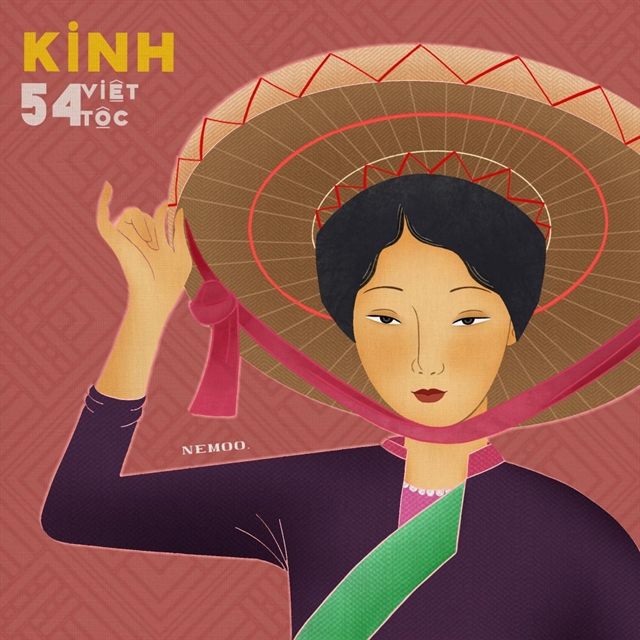 Features
Features

Faced by the tests of time and the import of other martial arts such as taekwondo, karate and MMA, Võ Bình Định is still growing, not only as a sport, but as an art form and a valuable aspect of Bình Định and Việt Nam's culture
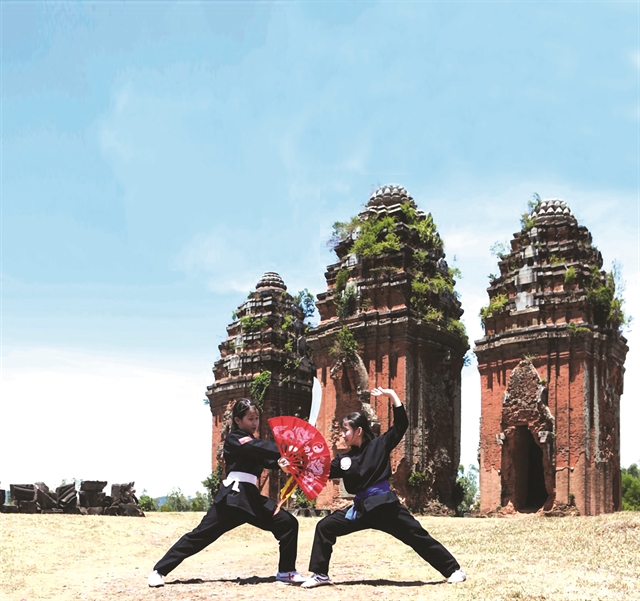
|
| Female martial artists of Phi Long dojo performing at Dương Long towers. —Photo vothuat.vn |
by Anh Đức
The south central province of Bình Định is the home of an art that has transcended time. It was so beloved by the locals, it became known after the province itself: Võ Bình Định (Bình Định Martial Art), a fighting form that is now on the cusp of UNESCO Intangible Cultural Heritage status.
The precise origins of Võ Bình Định have long remained a mystery. Historians speculate that it originated in the 15th century, during conquests in the south. As Bình Định was unstable during its early years, King Lê Thánh Tông sent warriors and generals there for peacekeeping. The generals eventually settled and their knowledge was passed down through generations, particularly martial arts.
Võ Bình Định further developed during the 18th century's Tây Sơn Dynasty, accumulating from exchanges with other martial art forms across the country.
Martial arts were then systemized and even became part of the national examinations, with the army itself being fully trained in Võ Bình Định. Dojos grew in numbers. Encouraged by the kingdom, Võ Bình Định was in its heyday.
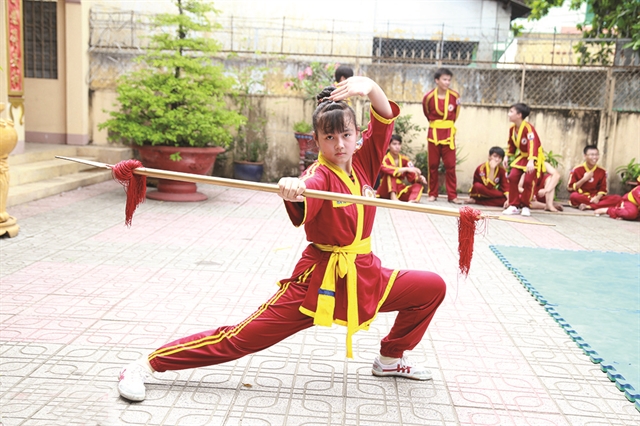
|
| Hà Gia Lợi, 13, makes an impression with her long staff use. — Photo vothuat.vn |
Over six hundred years later, the sound of masters and students practising Bình Định martial art has not faltered. There are currently 177 dojos housing over 12,000 practitioners with 101 masters across the province, according to the President of the Bình Định Martial Arts Federation, Bùi Trung Hiếu.
Multiple martial arts village are spread throughout Bình Định with a diversity in styles. Tây Sơn District has Phú Lạc, Xuân Hòa, An Vinh and Thuận Truyền villages; while Phù Cát District is famous for Phú Nhân, Đại An and Hòa Hội villages. An Nhơn District has An Thái and Thắng Công making their names.
British writer and martial arts expert Augustus Roe, the author of The Martial Arts of Vietnam, has studied the form and is an enthusiast for it.
“I spent some time in Bình Định to research the local systems. In doing so, I travelled to many of the renowned ‘Martial Art Villages’ in the region. Each of these tiny hamlets has their own specific flavour and speciality style,” Roe told Việt Nam News.
“For example, Thuận Truyền is known for staff fighting, An Vinh is known for its female fighters (the village was founded by a descendant of the legendary female warrior Bùi Thị Xuân), An Thái is known for its stronger (masculine) unarmed style and Long Phước Pagoda is known for its peaceful, Buddhist approach to combat.”

|
| Teaching Võ Bình Định in Phan Thọ dojo in Bình Định. — Photo www.bienphong.com.vn |
Bình Định martial art is special for its diversity, which encompasses a wide array of knowledge and weapons, from the many dojos across the province. It is relentless and powerful in attack, but calm and poised in defence, utilising the yin-yang theory in its development of punches and kicks.
Although diverse in styles, Bình Định martial art focuses on four basic aspects: respiratory training, empty hand combat, weaponized combat and willpower training.
The Vietnamese Bình Định Martial Art Federation divided the lessons of four aspects into seventeen routines, with weaponized combat utilising eighteen different weapons, including long staffs, swords, spears and axes.
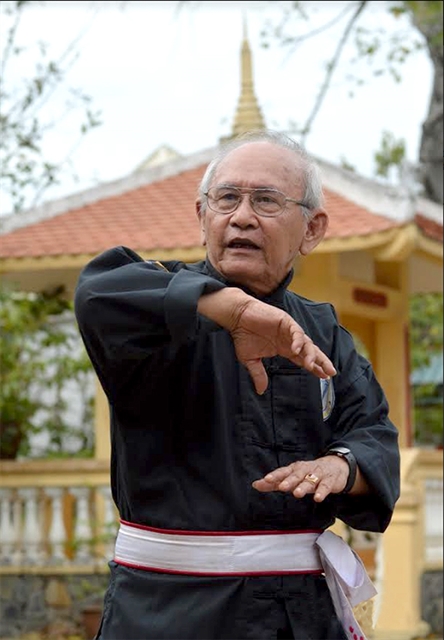
|
| Võ Minh Thế, founder of the Bình Định Tactician Martial Arts style. — Photo vothuat.vn |
The three most well-known styles in Bình Định martial art are the empty-hand styles of An Vinh and An Thái, and the Thuận Truyền long staff style. They have the most practitioners and their popularity is even etched into nursery rhymes.
A famous saying goes "Trai An Thái, gái An Vinh", which means that An Thái style is practised mostly by men, whereas An Vinh style is popular among women. It is based on the fact that the An Thái style utilises power in their moves, suitable for males. The An Vinh style, however, is based on speed and the assumption of a taller opponent, which made it easier for females to learn. The Thuận Truyền style, on the other hand, uses a long staff, a famous weapon among commoners in the past.
“During a visit to Long Phước Pagoda, I had an opportunity to train directly with Grandmaster Trương Văn Vinh (a descendant of the legendary Trương Văn Hiến, who taught the three leaders of the Tây Sơn Uprising). Sparring with some of his disciples, I was amazed at their creative approaches to dealing with my significant weight and height advantage. Their motto ‘Speed first, then strength and accuracy’ was certainly put into use effectively,” said Roe.
Perhaps one of the most famous masters of Bình Định martial art is master Phan Thọ (1926-2014). Nicknamed "Bình Định's greatest hands", Master Thọ was legendary for his knowledge and use of all eighteen weapons in Bình Định martial art.
Learning martial arts from the age of seventeen, he endured 18 years of travel and learning from multiple teachers across Bình Định. One of his most well-known victories was against a South Korean taekwondo martial artist in 1972. Although smaller than his opponent, Thọ was able to evade his opponent's attacks, before landing the famous "Viper Poison Attack" to knock out the Korean.
In 1998, he was again challenged by an arrogant taekwondo master from South Korea, who repeatedly mocked Vietnamese Martial Arts. The Korean fighter started the match with two powerful kicks, but Thọ evaded them with ease. Before the opponent was able to strike the third kick, Thọ found an opening, struck a powerful blow that made the Korean fall on his back and admit defeat.
Thọ continued his teachings until his death in 2014, passing his mantle to his son Phan Đức, before his grandson Phan Minh Hải took over in 2018.
The dojo of Hồ Ngạnh is well-known in Bình Định. Its namesake, Master Hồ Ngạnh was the best long staff user in the entire province. Hồ Ngạnh's mother, Lê Thị Quỳnh Hà, was a participant in the kingdom's martial arts competition and was one of his first teachers.
Hồ Ngạnh's famous move, the "Reverse Long Staff Strike" was taught and perfected by his mother and passed down to his followers and descendants. Today the Hồ family has a lineage spanning five generations, with a profound knowledge of martial arts and the Thuận Truyền long staff style.
Master Hồ Ngạnh passed away in 1976, and was posthumously honoured by the Việt Nam Institute for Martial Arts Research in 2018 for his contributions.
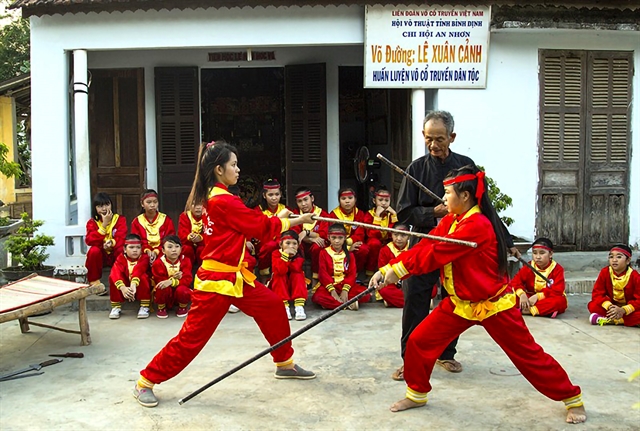
|
| Children practising at a dojo in Lê Xuân Cảnh. vothuat.vn |
The style continues to be studied by locals and foreigners alike and is widely admired for its traditions, and loyalty of its followers. It’s a martial art tradition that continues to leave Roe enthused.
“The most impressive aspect of Bình Định martial art for me is the pride and dedication that the region's martial artists feel for their system. For many in Bình Định, martial arts are simply a way of life; generations of families, groups of friends and husbands and wives train together with commitment and enthusiasm every single day,” Roe said.
“Although Bình Định is a place of stunning natural beauty, it has also suffered through centuries of hardships. However, despite all of this, the spirit, generosity and warmth of its fighting people still shine through. For me, this strength of character is what martial arts are truly about.”
In recognition of more than 500 years of development and contribution of Bình Định martial art to Vietnamese culture and sport, Deputy Prime Minister Vũ Đức Đam has granted permission for the Ministry of Culture, Sports and Tourism to begin the process of proposing that UNESCO recognise Bình Định martial art as an intangible cultural heritage, with many martial artists responded positively to the news.
Bình Định martial art has been a National Intangible Heritage since 2012, and the UNESCO move is likely to provide global exposure for this legendary martial art.
Faced by the tests of time and the import of other martial arts such as taekwondo, karate and MMA, Bình Định martial art is still growing, not only as a sport but as an art form and a valuable aspect of Bình Định and Việt Nam's culture as a whole. —VNS